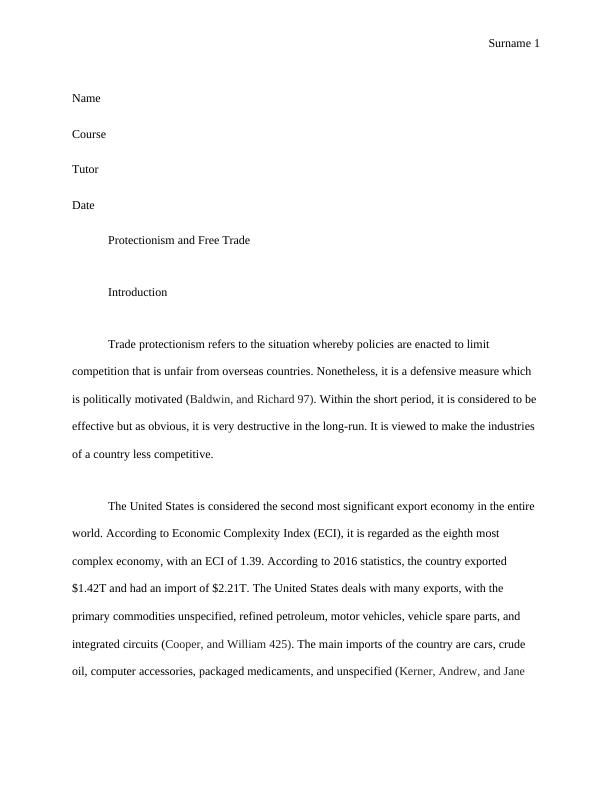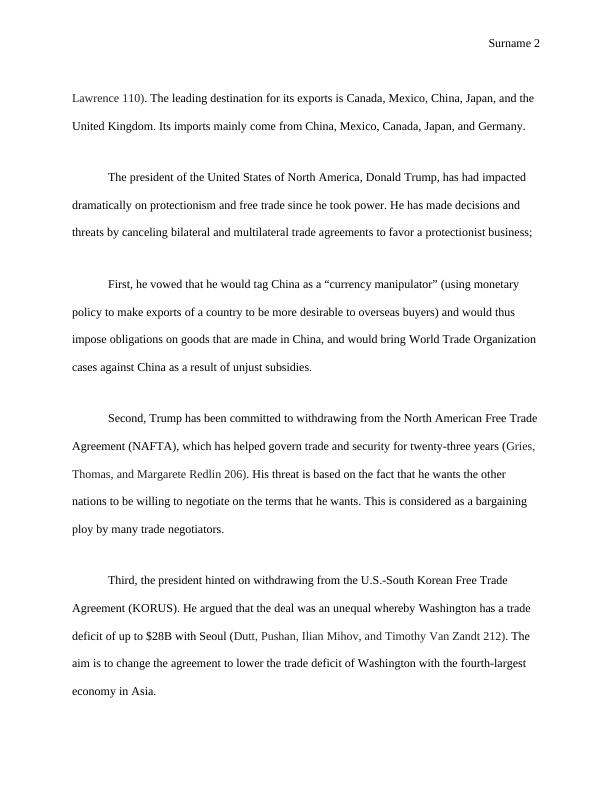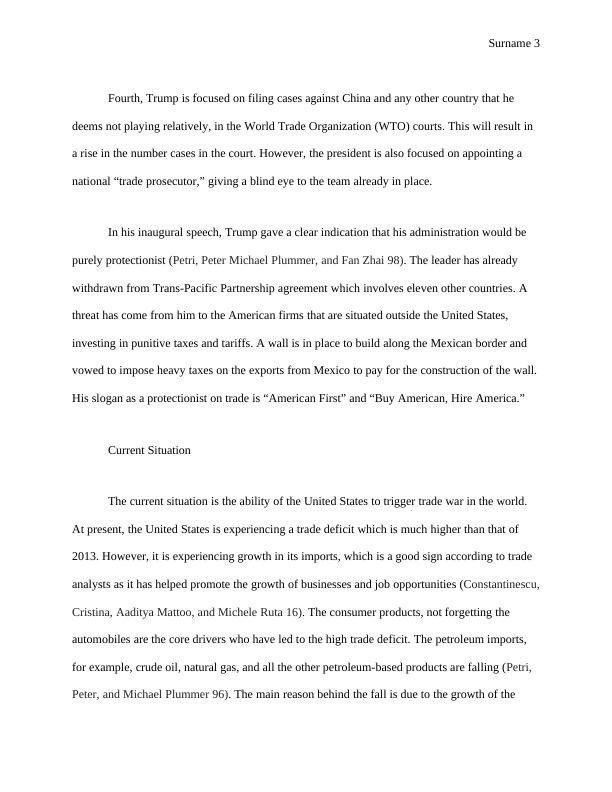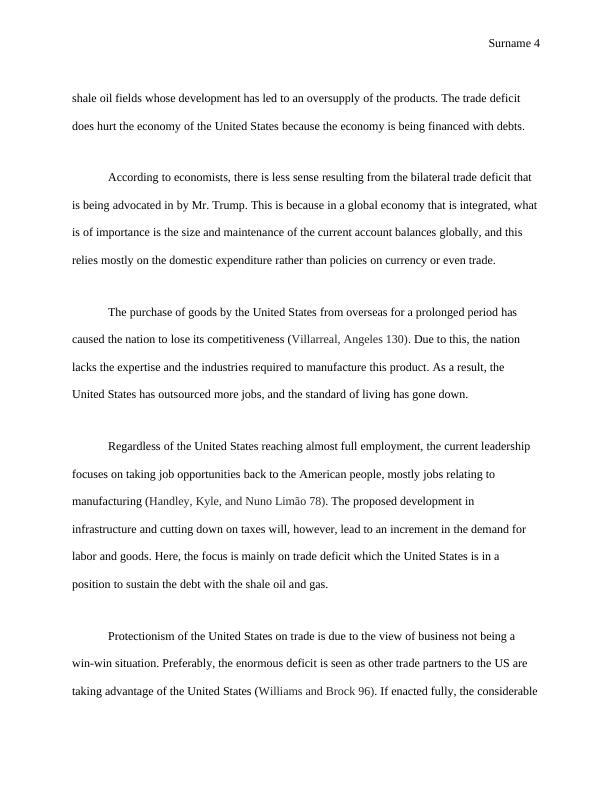Protectionism and Free Trade
15 Pages4240 Words50 Views
Added on 2020-05-01
Protectionism and Free Trade
Added on 2020-05-01
ShareRelated Documents
Surname 1
Name
Course
Tutor
Date
Protectionism and Free Trade
Introduction
Trade protectionism refers to the situation whereby policies are enacted to limit
competition that is unfair from overseas countries. Nonetheless, it is a defensive measure which
is politically motivated (Baldwin, and Richard 97). Within the short period, it is considered to be
effective but as obvious, it is very destructive in the long-run. It is viewed to make the industries
of a country less competitive.
The United States is considered the second most significant export economy in the entire
world. According to Economic Complexity Index (ECI), it is regarded as the eighth most
complex economy, with an ECI of 1.39. According to 2016 statistics, the country exported
$1.42T and had an import of $2.21T. The United States deals with many exports, with the
primary commodities unspecified, refined petroleum, motor vehicles, vehicle spare parts, and
integrated circuits (Cooper, and William 425). The main imports of the country are cars, crude
oil, computer accessories, packaged medicaments, and unspecified (Kerner, Andrew, and Jane
Name
Course
Tutor
Date
Protectionism and Free Trade
Introduction
Trade protectionism refers to the situation whereby policies are enacted to limit
competition that is unfair from overseas countries. Nonetheless, it is a defensive measure which
is politically motivated (Baldwin, and Richard 97). Within the short period, it is considered to be
effective but as obvious, it is very destructive in the long-run. It is viewed to make the industries
of a country less competitive.
The United States is considered the second most significant export economy in the entire
world. According to Economic Complexity Index (ECI), it is regarded as the eighth most
complex economy, with an ECI of 1.39. According to 2016 statistics, the country exported
$1.42T and had an import of $2.21T. The United States deals with many exports, with the
primary commodities unspecified, refined petroleum, motor vehicles, vehicle spare parts, and
integrated circuits (Cooper, and William 425). The main imports of the country are cars, crude
oil, computer accessories, packaged medicaments, and unspecified (Kerner, Andrew, and Jane

Surname 2
Lawrence 110). The leading destination for its exports is Canada, Mexico, China, Japan, and the
United Kingdom. Its imports mainly come from China, Mexico, Canada, Japan, and Germany.
The president of the United States of North America, Donald Trump, has had impacted
dramatically on protectionism and free trade since he took power. He has made decisions and
threats by canceling bilateral and multilateral trade agreements to favor a protectionist business;
First, he vowed that he would tag China as a “currency manipulator” (using monetary
policy to make exports of a country to be more desirable to overseas buyers) and would thus
impose obligations on goods that are made in China, and would bring World Trade Organization
cases against China as a result of unjust subsidies.
Second, Trump has been committed to withdrawing from the North American Free Trade
Agreement (NAFTA), which has helped govern trade and security for twenty-three years (Gries,
Thomas, and Margarete Redlin 206). His threat is based on the fact that he wants the other
nations to be willing to negotiate on the terms that he wants. This is considered as a bargaining
ploy by many trade negotiators.
Third, the president hinted on withdrawing from the U.S.-South Korean Free Trade
Agreement (KORUS). He argued that the deal was an unequal whereby Washington has a trade
deficit of up to $28B with Seoul (Dutt, Pushan, Ilian Mihov, and Timothy Van Zandt 212). The
aim is to change the agreement to lower the trade deficit of Washington with the fourth-largest
economy in Asia.
Lawrence 110). The leading destination for its exports is Canada, Mexico, China, Japan, and the
United Kingdom. Its imports mainly come from China, Mexico, Canada, Japan, and Germany.
The president of the United States of North America, Donald Trump, has had impacted
dramatically on protectionism and free trade since he took power. He has made decisions and
threats by canceling bilateral and multilateral trade agreements to favor a protectionist business;
First, he vowed that he would tag China as a “currency manipulator” (using monetary
policy to make exports of a country to be more desirable to overseas buyers) and would thus
impose obligations on goods that are made in China, and would bring World Trade Organization
cases against China as a result of unjust subsidies.
Second, Trump has been committed to withdrawing from the North American Free Trade
Agreement (NAFTA), which has helped govern trade and security for twenty-three years (Gries,
Thomas, and Margarete Redlin 206). His threat is based on the fact that he wants the other
nations to be willing to negotiate on the terms that he wants. This is considered as a bargaining
ploy by many trade negotiators.
Third, the president hinted on withdrawing from the U.S.-South Korean Free Trade
Agreement (KORUS). He argued that the deal was an unequal whereby Washington has a trade
deficit of up to $28B with Seoul (Dutt, Pushan, Ilian Mihov, and Timothy Van Zandt 212). The
aim is to change the agreement to lower the trade deficit of Washington with the fourth-largest
economy in Asia.

Surname 3
Fourth, Trump is focused on filing cases against China and any other country that he
deems not playing relatively, in the World Trade Organization (WTO) courts. This will result in
a rise in the number cases in the court. However, the president is also focused on appointing a
national “trade prosecutor,” giving a blind eye to the team already in place.
In his inaugural speech, Trump gave a clear indication that his administration would be
purely protectionist (Petri, Peter Michael Plummer, and Fan Zhai 98). The leader has already
withdrawn from Trans-Pacific Partnership agreement which involves eleven other countries. A
threat has come from him to the American firms that are situated outside the United States,
investing in punitive taxes and tariffs. A wall is in place to build along the Mexican border and
vowed to impose heavy taxes on the exports from Mexico to pay for the construction of the wall.
His slogan as a protectionist on trade is “American First” and “Buy American, Hire America.”
Current Situation
The current situation is the ability of the United States to trigger trade war in the world.
At present, the United States is experiencing a trade deficit which is much higher than that of
2013. However, it is experiencing growth in its imports, which is a good sign according to trade
analysts as it has helped promote the growth of businesses and job opportunities (Constantinescu,
Cristina, Aaditya Mattoo, and Michele Ruta 16). The consumer products, not forgetting the
automobiles are the core drivers who have led to the high trade deficit. The petroleum imports,
for example, crude oil, natural gas, and all the other petroleum-based products are falling (Petri,
Peter, and Michael Plummer 96). The main reason behind the fall is due to the growth of the
Fourth, Trump is focused on filing cases against China and any other country that he
deems not playing relatively, in the World Trade Organization (WTO) courts. This will result in
a rise in the number cases in the court. However, the president is also focused on appointing a
national “trade prosecutor,” giving a blind eye to the team already in place.
In his inaugural speech, Trump gave a clear indication that his administration would be
purely protectionist (Petri, Peter Michael Plummer, and Fan Zhai 98). The leader has already
withdrawn from Trans-Pacific Partnership agreement which involves eleven other countries. A
threat has come from him to the American firms that are situated outside the United States,
investing in punitive taxes and tariffs. A wall is in place to build along the Mexican border and
vowed to impose heavy taxes on the exports from Mexico to pay for the construction of the wall.
His slogan as a protectionist on trade is “American First” and “Buy American, Hire America.”
Current Situation
The current situation is the ability of the United States to trigger trade war in the world.
At present, the United States is experiencing a trade deficit which is much higher than that of
2013. However, it is experiencing growth in its imports, which is a good sign according to trade
analysts as it has helped promote the growth of businesses and job opportunities (Constantinescu,
Cristina, Aaditya Mattoo, and Michele Ruta 16). The consumer products, not forgetting the
automobiles are the core drivers who have led to the high trade deficit. The petroleum imports,
for example, crude oil, natural gas, and all the other petroleum-based products are falling (Petri,
Peter, and Michael Plummer 96). The main reason behind the fall is due to the growth of the

Surname 4
shale oil fields whose development has led to an oversupply of the products. The trade deficit
does hurt the economy of the United States because the economy is being financed with debts.
According to economists, there is less sense resulting from the bilateral trade deficit that
is being advocated in by Mr. Trump. This is because in a global economy that is integrated, what
is of importance is the size and maintenance of the current account balances globally, and this
relies mostly on the domestic expenditure rather than policies on currency or even trade.
The purchase of goods by the United States from overseas for a prolonged period has
caused the nation to lose its competitiveness (Villarreal, Angeles 130). Due to this, the nation
lacks the expertise and the industries required to manufacture this product. As a result, the
United States has outsourced more jobs, and the standard of living has gone down.
Regardless of the United States reaching almost full employment, the current leadership
focuses on taking job opportunities back to the American people, mostly jobs relating to
manufacturing (Handley, Kyle, and Nuno Limão 78). The proposed development in
infrastructure and cutting down on taxes will, however, lead to an increment in the demand for
labor and goods. Here, the focus is mainly on trade deficit which the United States is in a
position to sustain the debt with the shale oil and gas.
Protectionism of the United States on trade is due to the view of business not being a
win-win situation. Preferably, the enormous deficit is seen as other trade partners to the US are
taking advantage of the United States (Williams and Brock 96). If enacted fully, the considerable
shale oil fields whose development has led to an oversupply of the products. The trade deficit
does hurt the economy of the United States because the economy is being financed with debts.
According to economists, there is less sense resulting from the bilateral trade deficit that
is being advocated in by Mr. Trump. This is because in a global economy that is integrated, what
is of importance is the size and maintenance of the current account balances globally, and this
relies mostly on the domestic expenditure rather than policies on currency or even trade.
The purchase of goods by the United States from overseas for a prolonged period has
caused the nation to lose its competitiveness (Villarreal, Angeles 130). Due to this, the nation
lacks the expertise and the industries required to manufacture this product. As a result, the
United States has outsourced more jobs, and the standard of living has gone down.
Regardless of the United States reaching almost full employment, the current leadership
focuses on taking job opportunities back to the American people, mostly jobs relating to
manufacturing (Handley, Kyle, and Nuno Limão 78). The proposed development in
infrastructure and cutting down on taxes will, however, lead to an increment in the demand for
labor and goods. Here, the focus is mainly on trade deficit which the United States is in a
position to sustain the debt with the shale oil and gas.
Protectionism of the United States on trade is due to the view of business not being a
win-win situation. Preferably, the enormous deficit is seen as other trade partners to the US are
taking advantage of the United States (Williams and Brock 96). If enacted fully, the considerable

End of preview
Want to access all the pages? Upload your documents or become a member.
Related Documents
Trump's Nationalistic Philosophylg...
|5
|771
|441
Protectionism & Free Trade Assignmentlg...
|15
|4017
|181
The Way Governments Use Fiscal and Monetary Policies to Stimulate Economic Activity and Growthlg...
|8
|2294
|58
NAFTA and Trans-Pacific Partnership: Impact on Member Countrieslg...
|14
|3816
|163
Protectionism and Free Trade Assignmentlg...
|14
|3993
|56
Impact of Protectionist Policy on Macroeconomic Stability: A Case Study of United States and Australialg...
|9
|1499
|57
